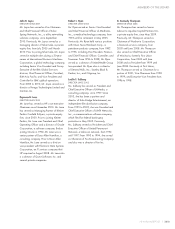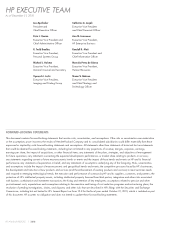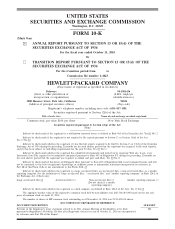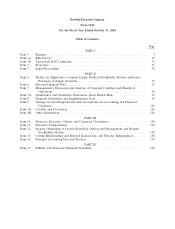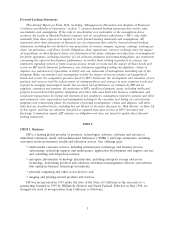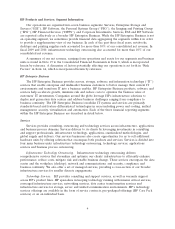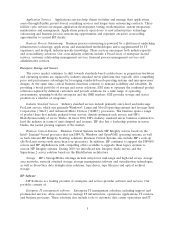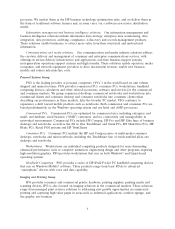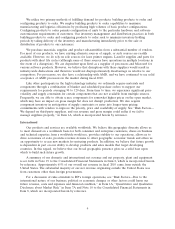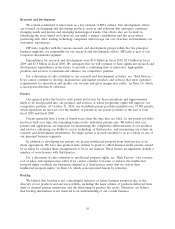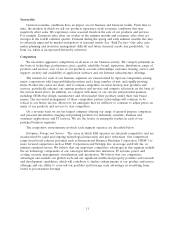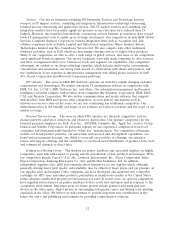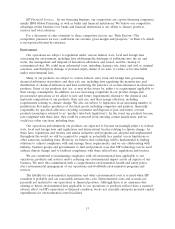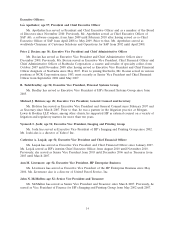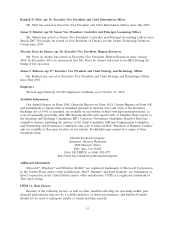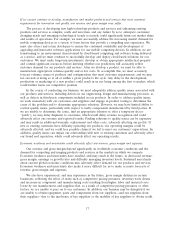HP 2010 Annual Report Download - page 17
Download and view the complete annual report
Please find page 17 of the 2010 HP annual report below. You can navigate through the pages in the report by either clicking on the pages listed below, or by using the keyword search tool below to find specific information within the annual report.We utilize two primary methods of fulfilling demand for products: building products to order and
configuring products to order. We employ building products to order capabilities to maximize
manufacturing and logistics efficiencies by producing high volumes of basic product configurations.
Configuring products to order permits configuration of units to the particular hardware and software
customization requirements of customers. Our inventory management and distribution practices in both
building products to order and configuring products to order seek to minimize inventory holding
periods by taking delivery of the inventory and manufacturing immediately prior to the sale or
distribution of products to our customers.
We purchase materials, supplies and product subassemblies from a substantial number of vendors.
For most of our products, we have existing alternate sources of supply, or such sources are readily
available. However, we do rely on sole sources for laser printer engines, LaserJet supplies and parts for
products with short life cycles (although some of these sources have operations in multiple locations in
the event of a disruption). We are dependent upon Intel as a supplier of processors and Microsoft for
various software products. However, we believe that disruptions with these suppliers would result in
industry-wide dislocations and therefore would not disproportionately disadvantage us relative to our
competitors. For processors, we also have a relationship with AMD, and we have continued to see solid
acceptance of AMD processors in the market during fiscal 2010.
Like other participants in the high technology industry, we ordinarily acquire materials and
components through a combination of blanket and scheduled purchase orders to support our
requirements for periods averaging 90 to 120 days. From time to time, we experience significant price
volatility and supply constraints for certain components that are not available from multiple sources.
Frequently, we are able to obtain scarce components for somewhat higher prices on the open market,
which may have an impact on gross margin but does not disrupt production. We also acquire
component inventory in anticipation of supply constraints or enter into longer-term pricing
commitments with vendors to improve the priority, price and availability of supply. See ‘‘Risk Factors—
We depend on third-party suppliers, and our revenue and gross margin could suffer if we fail to
manage suppliers properly,’’ in Item 1A, which is incorporated herein by reference.
International
Our products and services are available worldwide. We believe this geographic diversity allows us
to meet demand on a worldwide basis for both consumer and enterprise customers, draws on business
and technical expertise from a worldwide workforce, provides stability to our operations, allows us to
drive economies of scale, provides revenue streams to offset geographic economic trends and offers us
an opportunity to access new markets for maturing products. In addition, we believe that future growth
is dependent in part on our ability to develop products and sales models that target developing
countries. In this regard, we believe that our broad geographic presence gives us a solid base upon
which to build such future growth.
A summary of our domestic and international net revenue and net property, plant and equipment
is set forth in Note 19 to the Consolidated Financial Statements in Item 8, which is incorporated herein
by reference. Approximately 65% of our overall net revenue in fiscal 2010 came from outside the
United States. The substantial majority of our net revenue originating outside the United States was
from customers other than foreign governments.
For a discussion of risks attendant to HP’s foreign operations, see ‘‘Risk Factors—Due to the
international nature of our business, political or economic changes or other factors could harm our
future revenue, costs and expenses and financial condition,’’ in Item 1A, ‘‘Quantitative and Qualitative
Disclosure about Market Risk’’ in Item 7A and Note 10 to the Consolidated Financial Statements in
Item 8, which are incorporated herein by reference.
9


